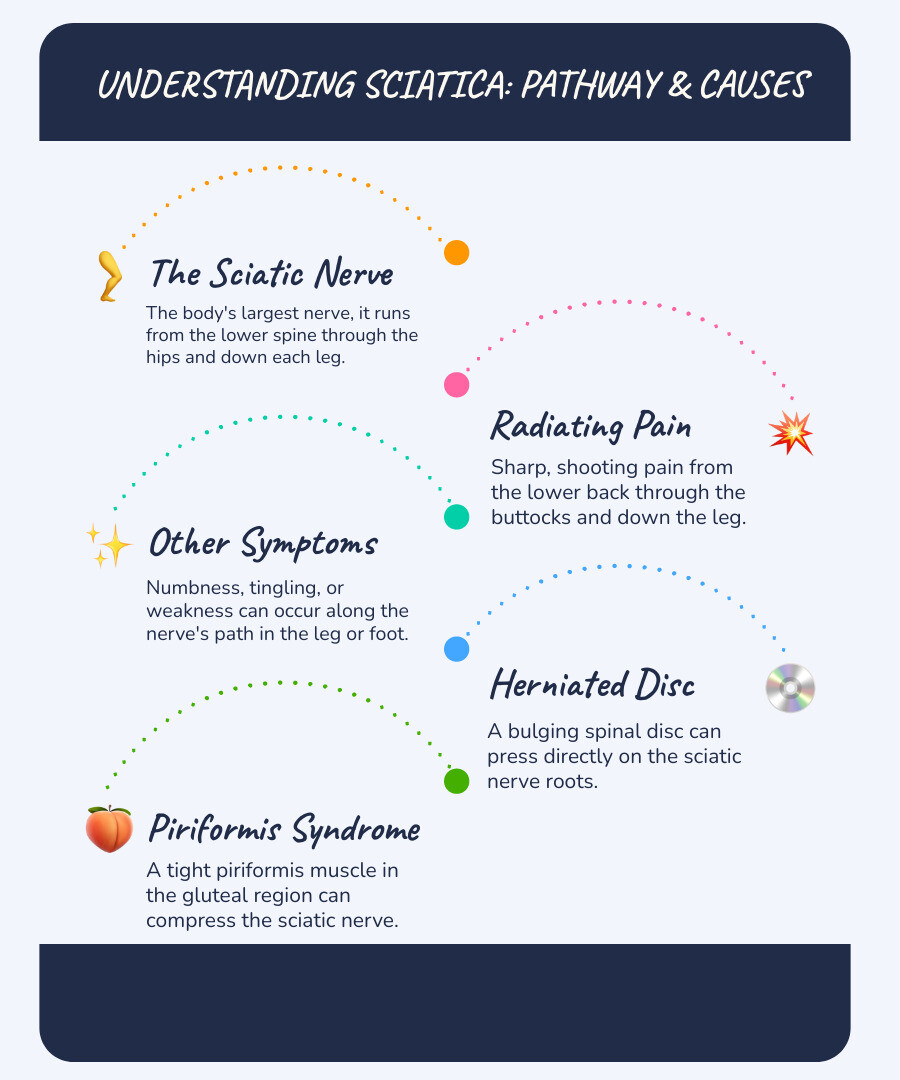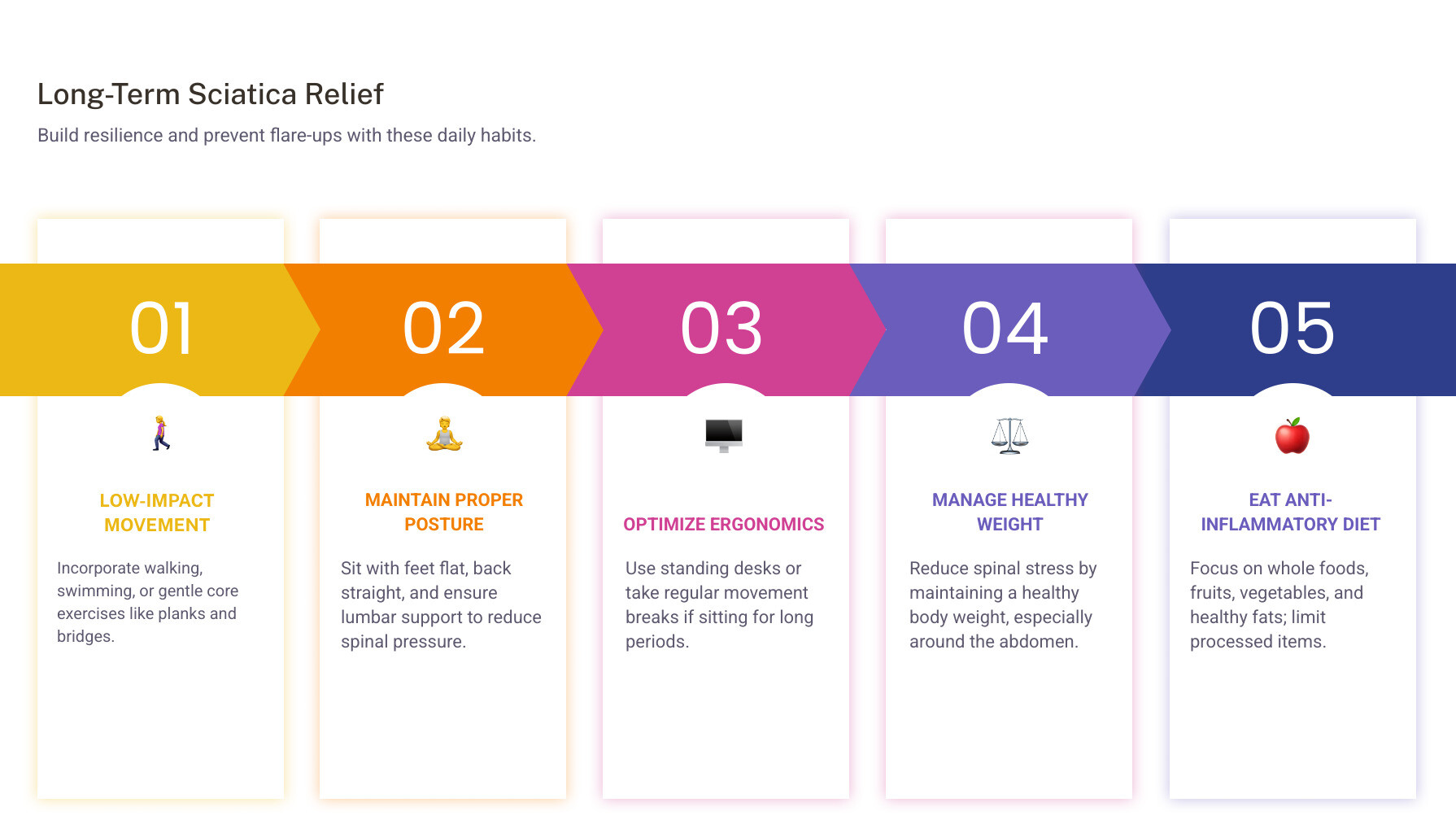Understanding the Path to Sciatica Pain Relief
Natural sciatica relief is possible through a combination of proven home remedies, professional therapies, and lifestyle adjustments that address the root causes of nerve pain. The good news? About 90% of people with sciatica will get better without surgery—most of them in just a few weeks.
Quick Natural Relief Options:
- Heat and cold therapy - Ice for inflammation, heat for muscle relaxation
- Gentle stretches - Figure-4 stretch, knee-to-chest, piriformis stretch
- Topical nerve pain relief cream - Natural ingredients like menthol and aloe
- Low-impact movement - Walking, swimming, yoga
- Professional care - Chiropractic adjustments, massage therapy
Sciatica affects up to 40% of people during their lifetime, causing sharp, shooting pain that travels from your lower back down through your buttocks and legs. This pain occurs when the sciatic nerve—the largest nerve in your body—becomes compressed or irritated.
The sciatic nerve runs from your lower spine, through your hips and buttocks, and down each leg. When something pinches or inflames this nerve, you might experience not just pain, but also numbness, tingling, or weakness in your leg or foot.
Common causes include herniated discs, bone spurs, spinal stenosis, or tight muscles like the piriformis pressing against the nerve. While the pain can be intense and disruptive, most cases respond well to natural treatments when applied consistently.
I'm Tony Enrico, and through my work developing advanced pain relief formulas at Neuropasil, I've helped countless athletes and individuals find effective natural sciatica relief using targeted topical solutions combined with proven therapeutic approaches. My experience has shown that the right combination of natural remedies can provide both immediate comfort and long-term healing.

Immediate Relief: At-Home Strategies for Managing Flare-Ups
When sciatica strikes, you want immediate relief. Thankfully, several simple, natural strategies can be implemented from home to manage painful flare-ups. These methods focus on reducing inflammation, relaxing tense muscles, and gently encouraging healing.
The Power of Temperature: Heat and Cold Therapy
Temperature therapy is one of the oldest and most effective methods for pain relief. Both ice and heat have distinct benefits for sciatica, and knowing when to use each can make a significant difference.
Cold Packs for Inflammation: For acute pain or a recent flare-up, inflammation is often the primary culprit. This is where cold therapy shines. Applying an ice pack to your lower back, where the sciatic nerve originates, helps reduce inflammation and numb the area, dulling pain signals. During the first few days of a flare-up, apply an ice pack for 15-20 minutes at a time, with a 15-20 minute break in between. Always wrap the ice pack in a thin cloth to protect your skin.
Ice Massage Technique: For a more targeted treatment, an ice massage can be very effective. Freeze water in a paper cup, tear away the top to expose the ice, and gently rub it in a circular motion over your lower back for no more than 10 minutes, avoiding the bony part of your spine. This combines the numbing effect of ice with gentle massage. Wait at least an hour between massages.
Heat Pads for Muscle Relaxation: After the initial inflammation subsides (typically after a few days), or for chronic muscle stiffness, heat therapy is your best friend. Heat increases blood flow to the area, which helps relax tight muscles and promote healing. It’s particularly useful when muscles feel tense from guarding the injured nerve.
Use a heating pad, a hot water bottle, or a warm, moist compress. Ensure the heat is comfortably warm, not hot, and place a cloth barrier between the heat and your skin to prevent burns. Apply heat for at least 15 minutes, but no longer than two hours. It's a fantastic way to loosen muscles and alleviate pressure on the sciatic nerve.
Warm Baths: A warm bath offers full-body relaxation. The heat penetrates deeply, relaxing muscles in your back and hips and improving circulation. Adding Epsom salts can further improve muscle relaxation and help tension melt away.
When to Use Ice vs. Heat: The general rule is: use ice for acute pain and swelling (the first 24-72 hours), and heat for chronic pain and muscle stiffness. Some people find alternating them (contrast therapy) beneficial. Experiment to see what works best for you. For more detailed guidance, you can explore managing pain with temperature therapy.
Gentle Movement and Key Stretches for Natural Sciatica Relief
While it may seem counterintuitive, movement is your ally against sciatica. Research shows that prolonged bed rest often makes sciatica worse by causing muscle weakness and stiffness, which can further aggravate the nerve. Instead, gentle, consistent movement strengthens muscles, improves flexibility, and boosts blood flow.
Importance of Staying Active: Our bodies are designed to move. Staying as active as possible within comfortable limits is crucial for recovery. Low-impact activities like walking or swimming are excellent choices because they loosen the sciatic nerve and surrounding muscles without straining your spine. If movement increases your pain, consult a healthcare professional.
Effective Sciatica Stretches: Stretching is a cornerstone of natural sciatica relief. The goal is to gently lengthen muscles that may be compressing the sciatic nerve. As certified strength and conditioning specialist Dr. Mark Kovacs notes, "any stretch that can externally rotate the hip to provide some relief" is often effective. Hold each stretch for at least 30 seconds, breathe deeply, and never push into pain. If it hurts, stop.
Here are some of our favorite stretches:
-
Figure-4 Stretch: A fantastic hip opener.
- Lie on your back with your knees bent and feet flat on the floor.
- Cross your affected leg's ankle over the opposite knee, forming a "figure 4."
- Gently pull the thigh of the uncrossed leg towards your chest until you feel a stretch in your glute and hip.
- Hold for 30 seconds, then switch sides.
-
Knee-to-Opposite-Shoulder: This targets the piriformis muscle.
- Lie on your back with both legs extended.
- Bend your affected knee and grab it with both hands.
- Gently pull your knee across your body towards your opposite shoulder.
- Hold for 30 seconds.
-
Standing Hamstring Stretch: Tight hamstrings can contribute to sciatica symptoms.
- Place your heel on an liftd surface (like a chair or step) with your leg straight.
- Keep your back straight and gently lean forward from your hips until you feel a stretch in the back of your thigh.
- Hold for 30 seconds, then switch legs.
-
Pigeon Pose (Modified or Full): A deeper, beneficial hip opener.
- Start on all fours. Bring your affected knee forward towards your hands, placing your foot near your opposite hip.
- Extend your other leg straight back behind you.
- Gently lower your hips towards the floor. You can stay upright or lean forward over your front leg.
- Hold for 30 seconds, then switch sides.
Stretching should be a gentle pull, not painful. As physical therapist Corina Martinez emphasizes, there's no "one-size-fits-all" exercise for sciatica, so listen to your body. For more on managing nerve pain, check out our insights on Sciatic Nerve Pain.

Soothing Topical Solutions for Targeted Nerve Pain
Sometimes, you need extra help right where it hurts. That's where a high-quality nerve pain relief cream or muscle pain relief cream can provide localized comfort, addressing inflammation and soreness directly at the source.
Our Neuropasil topical creams are designed for this purpose, formulated with natural ingredients like Menthol, Aloe, and Urea that work synergistically for fast-acting relief.
- Menthol provides a cooling sensation that helps distract from pain signals and can temporarily numb the affected area.
- Aloe is known for its soothing and anti-inflammatory properties, helping to calm irritated skin and reduce local inflammation.
- Urea acts as a powerful humectant, hydrating the skin to improve the absorption of other beneficial ingredients.
When applied, these creams deliver their active ingredients directly to the nerve endings and muscle tissues. This localized approach targets the exact area of discomfort, reducing inflammation and easing muscle soreness without the systemic effects of oral medications. This targeted approach can be a crucial part of your daily pain management regimen, helping you find relief and get back to your activities.
Professional Hands-On Therapies for Deeper Healing
While home remedies are powerful, sometimes sciatica pain requires the skilled hands of a trained professional. These deeper healing approaches can address underlying issues that are difficult to tackle on your own, offering more profound relief.
Chiropractic Care for Spinal Alignment
Chiropractic care focuses on correcting spinal misalignments (subluxations) that can put pressure on your sciatic nerve. Chiropractors use precise, controlled movements called spinal manipulations to gently realign vertebrae, aiming to reduce nerve pressure and restore proper function to your spine.
Many people find significant relief from sciatica through this approach because it addresses a root cause of the discomfort, not just the symptoms. When your spine is properly aligned, the sciatic nerve has more room, which can reduce irritation and pain.
The safety of chiropractic care is well-documented, with research showing that spinal manipulation is as safe and effective as standard treatments for lower back pain. Always choose a licensed, experienced chiropractor who understands your specific situation. You can explore more about the evidence for spinal manipulation to help guide your decision.
The Role of Massage and Acupuncture
Beyond chiropractic care, massage therapy and acupuncture are two other valuable hands-on therapies for natural sciatica relief.
Massage therapy can be a game-changer, especially when tight muscles are the culprit. The piriformis muscle, located deep in the buttock, often spasms and squeezes the sciatic nerve, a condition known as piriformis syndrome.
A skilled massage therapist can release these tight muscles, improve circulation, and reduce nerve pressure. A piriformis muscle focus is particularly important, as releasing this deep muscle can provide almost immediate relief for many people.
Acupuncture offers a different approach. During treatment, ultra-thin needles are placed at specific points to stimulate your body's natural healing response. From a Western medical perspective, this is thought to work by encouraging the release of endorphins—the body's natural painkillers.
While the evidence for acupuncture is mixed and results can vary, some studies show great promise for back pain and sciatica relief. The FDA has approved acupuncture for treating back and chronic pain, which speaks to its legitimacy as a treatment option.
Trigger point therapy, delivered through either massage or acupuncture, is also highly effective. By targeting painful knots in your muscles, this approach can release tension and provide relief that extends far beyond the immediate treatment area.
These professional therapies complement each other and your at-home routine. Combining them often provides more comprehensive relief than any single approach alone.
Building Resilience: Long-Term Lifestyle Habits for Natural Sciatica Relief
While immediate relief is important, the real magic happens when you build long-term habits to keep sciatica from returning. These lifestyle choices create a protective shield for your sciatic nerve. The good news is that small, consistent adjustments to how you move, sit, and care for your body can make an enormous difference.
The Importance of an Active, Low-Impact Lifestyle
Staying active is one of the most powerful forms of natural sciatica relief. Regular activity helps maintain a healthy weight, strengthens the core muscles that support your spine, and keeps your body flexible and well-circulated.
Walking is a simple yet powerful tool. It keeps your spine flexible, strengthens leg and core muscles, and promotes good circulation. Even a daily 20-minute walk can work wonders.
Swimming is often called the "perfect exercise" for back pain. The water's buoyancy supports your spine and joints, allowing for impact-free strengthening. The backstroke is especially good for promoting proper spinal alignment.
Core strengthening exercises are vital. Strong core muscles act as a natural brace for your spine, reducing strain on your lower back. Planks are fantastic for engaging your abdominal muscles. Bridges work the glutes and lower back. The bird dog exercise builds both strength and coordination while keeping your core stable.
Consistency is more important than intensity. Aim for at least 30 minutes of moderate activity most days of the week. Your body will thank you for the gentle, regular movement.
Everyday Adjustments: Posture and Ergonomics
How you spend your day, especially sitting, can sabotage your progress. Dr. David Petron, a sports medicine physician, notes that "the most common reason [for sciatica and lower back pain] is really prolonged sitting." This puts immense pressure on spinal discs, tightens hip flexors, and weakens glutes—a perfect storm for sciatic nerve compression.
Proper sitting posture is a game-changer. Keep your feet flat on the floor with your knees and hips at 90-degree angles. Sit with a straight back and relaxed shoulders, using a lumbar cushion for support if needed. Avoid crossing your legs or slouching to reduce pressure on the sciatic nerve.
Ergonomic furniture, like a supportive office chair or a standing desk, is a worthwhile investment. Alternating between sitting and standing reduces the constant pressure on your lower back.
If a standing desk isn't an option, set a timer to get up and move every 30 minutes. A short walk, a few stretches, or simply standing and shifting your weight can make a big difference.
Healthy weight management is also crucial. Extra weight, particularly around the midsection, adds stress to your spine. The active lifestyle discussed earlier naturally helps manage weight.
An anti-inflammatory diet supports your efforts from within. While there's no specific "sciatica diet," focusing on whole foods like fruits, vegetables, lean proteins, and healthy fats helps reduce systemic inflammation. Limit processed foods, sugary drinks, and unhealthy fats that can fuel it.

Building these habits takes time, but each small change moves you closer to a life where sciatica doesn't call the shots. Combined with immediate relief strategies and professional therapies, these lifestyle adjustments create a comprehensive approach to natural sciatica relief.
Frequently Asked Questions about Sciatica
When you're dealing with sciatica, it's natural to have questions. Here are straightforward answers based on experience and research.
How long does it take for sciatica to go away naturally?
Recovery time for sciatica varies, but the outlook is positive: about 90% of people get better without surgery, often within just a few weeks. The timeline can range from a few days to a couple of months, depending on the cause, severity, and how consistently you follow your treatment plan.
Minor issues like tight piriformis muscles often resolve faster than complex spinal problems. Consistency with your routine—ice packs, gentle stretches, and nerve pain relief cream—is the key to success.
What is the single best stretch for sciatica?
There's no single "best" stretch for sciatica, as it's a highly individual condition. However, as Dr. Mark Kovacs notes, stretches that "externally rotate the hip to provide some relief" are often effective. The Figure-4 stretch and the knee-to-opposite-shoulder stretch are excellent examples, as they target key muscles around the sciatic nerve.
The best stretch is the one that provides relief for your body. Listen to its signals and stop if you feel sharp pain. A physical therapist or chiropractor can provide a personalized stretching plan and ensure you're performing movements safely and effectively.
When should I see a doctor for sciatica pain?
While natural remedies are effective, it's crucial to know when to seek professional medical help. Don't try to tough it out if you experience any red flags.
You should see a doctor if your pain persists for more than a month despite consistent home treatment. Also, seek professional help for severe, worsening pain that interferes with your daily life, such as sleeping or working.
Watch out for these red flag symptoms that need immediate medical attention:
- Loss of bladder or bowel control - this is a medical emergency, so get help right away
- Significant leg weakness that's getting worse
- Numbness that's spreading or intensifying
- Sudden, severe pain following an injury like a car accident
Your doctor can diagnose the cause of your sciatica, rule out more serious conditions, and recommend next steps like imaging or physical therapy. Seeking professional help is a smart part of any natural sciatica relief strategy. For more comprehensive information, check out our detailed guide on Sciatica Relief.
Conclusion: Your Next Steps Toward a Pain-Free Life
Your journey to freedom from sciatica pain can be straightforward. This guide has outlined a comprehensive approach to natural sciatica relief that puts you in control.
We've covered immediate relief strategies like temperature therapy, gentle stretches, and targeted topical solutions. We also explored professional therapies like chiropractic, massage, and acupuncture, which address root causes and work well with your home care routine. Most importantly, building long-term resilience through lifestyle adjustments like staying active with low-impact exercises and improving your ergonomics is your best defense against future flare-ups.
About 90% of people with sciatica get better without surgery, often within a few weeks. The key is consistency and patience as your body heals.
At Neuropasil, we know that extra support can make all the difference. Our nerve pain relief cream and muscle pain relief cream use natural ingredients like Menthol, Aloe, and Urea for targeted comfort. They are designed to complement your other healing strategies, whether for sciatica, neuropathy, or post-workout muscle soreness.
You don't have to accept pain as your new normal. A combination of gentle movement, self-care, professional guidance, and effective topical relief can transform your life. Every consistent step builds toward lasting freedom from pain.
Ready to take control of your sciatica naturally? Explore how Neuropasil's targeted approach to pain relief can support your journey back to comfortable, active living. Find more about our comprehensive solutions at Nerve Pain Relief with Neuropasil Natural Solutions and take that important next step toward the pain-free life you deserve.














